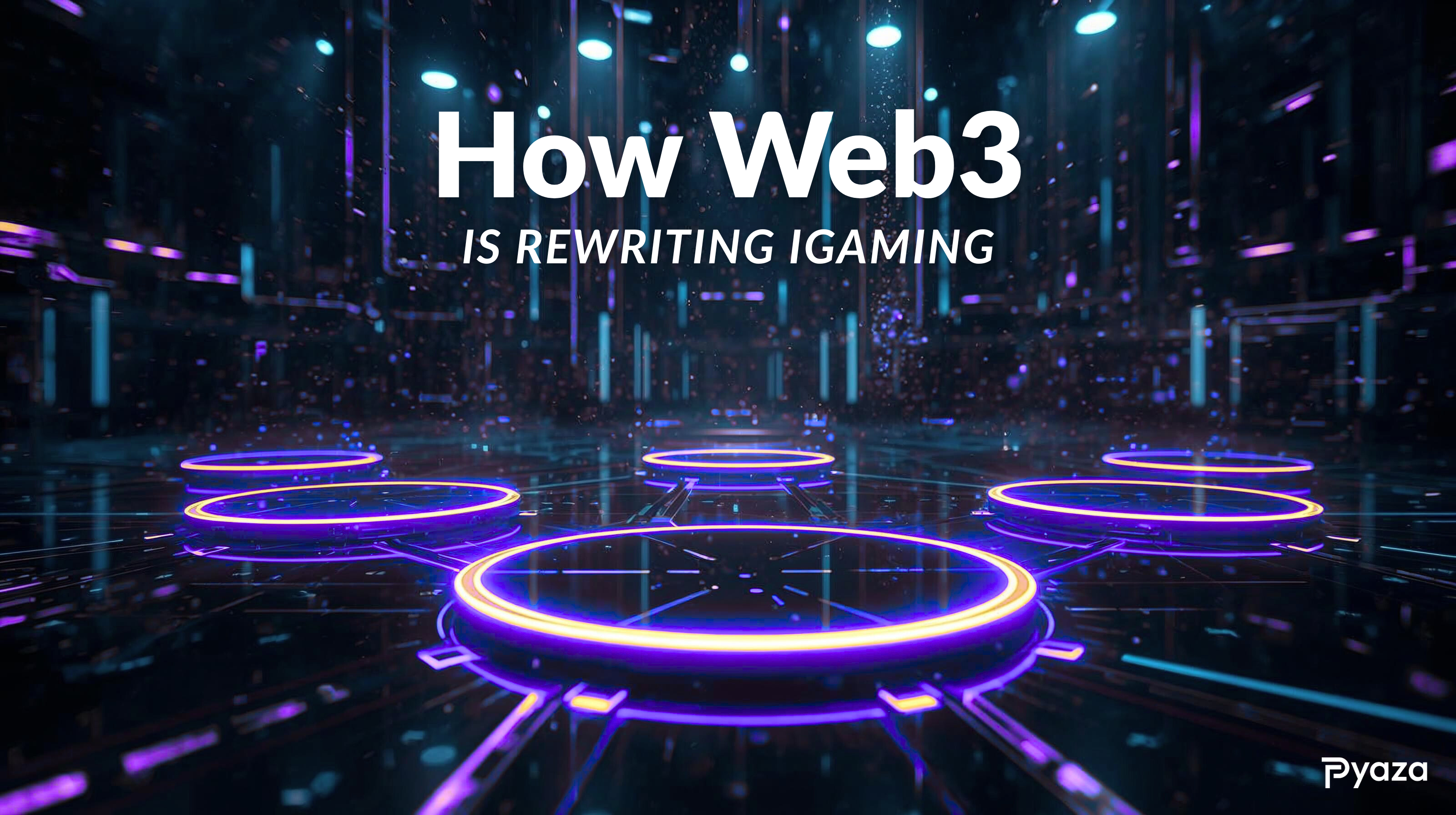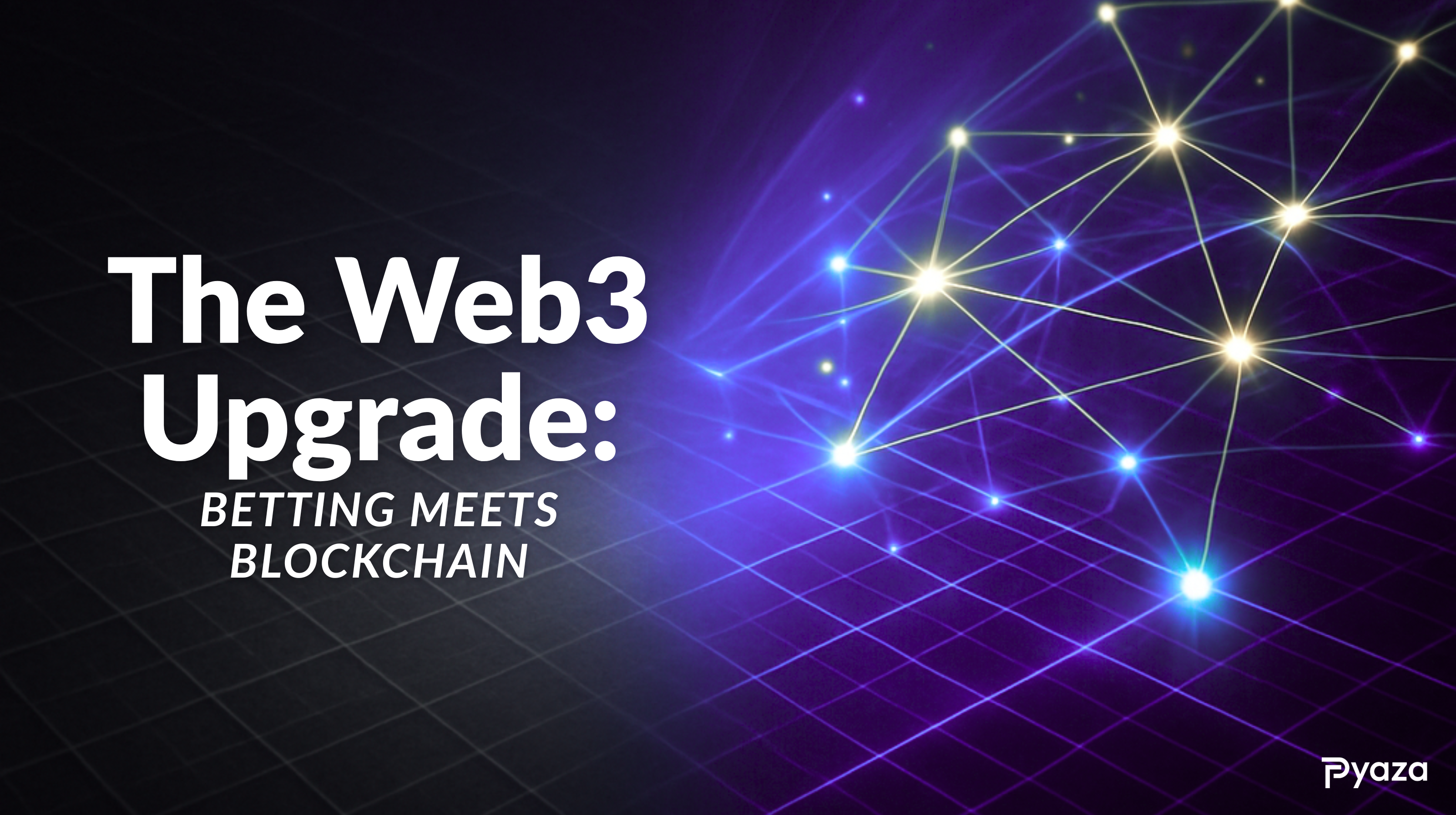How Web3 is Rewriting iGaming
The Shift to On-Chain Betting Ecosystems
)
Miguel Spiteri
Marketing Manager - Pyaza
Introduction
The iGaming world has always chased the next big upgrade. From casino floors to mobile screens, every leap in technology has redefined how players compete, connect, and win. But the next revolution isn’t happening on a casino floor - it’s happening on-chain. Welcome to Web3, where trust is written in code, not fine print. A world where fairness is visible, ownership is digital, and innovation deals the cards.

Why Traditional iGaming Needs an Upgrade
Online casinos solved accessibility, and mobile apps solved convenience, but transparency has always been iGaming’s blind spot. For years, players have trusted the system without really being able to see what happens behind the screen. The code that determines wins and losses is often locked away in private servers, invisible to anyone outside the operator’s control.
Players have long asked the same questions: is this RNG truly random? where is my payout? and how do I know the odds were not adjusted mid-game?
In traditional systems, the Random Number Generator (RNG) - the software that creates outcomes like dice rolls or card draws, is certified by auditors, but players must take their word for it. You never actually see the math.
The same goes for RTP (Return to Player) values, which indicate how much a game is designed to pay back over time. A slot might advertise a 96% RTP, but players have no way of verifying whether that figure is accurate or consistently applied.
That’s where Web3 steps in and changes everything. With smart contracts, results are generated by self-executing code that everyone can inspect. With public ledgers, every transaction, wager, and payout is recorded for anyone to verify. And with provably fair algorithms, players can check for themselves that the game’s results were random and untampered.
What makes this even more revolutionary is the possibility of real-time transparency. Imagine being able to see a game’s RNG seed or RTP data updating live on-chain - visible to every player, regulator, or developer. Instead of trusting monthly reports or third-party audits, fairness would be proven instantly, as the game unfolds. It is not a distant dream; several blockchain gaming projects are already experimenting with live on-chain metrics that let users track performance and randomness as it happens.
Think of it as the shift from “trust the casino” to “verify through code.” The house might still have an edge, but at least now you can see the cards being shuffled - digitally and transparently.

The Web3 Upgrade: Betting Meets Blockchain
When a casino operates on-chain, every transaction and payout is visible and verifiable. This single change transforms the entire experience for both players and operators.
1. Provably Fair Gaming
In traditional online casinos, fairness is something you are told about, not something you can prove. You click “spin,” hope for a win. You trust that the Random Number Generator behind the scenes is doing its job honestly. But you never actually see the mechanism.
With Web3, that invisible process becomes transparent. A provably fair system uses cryptographic formulas to show exactly how each game result was created.
Here is how it works in simple terms: before every round begins, the platform generates a secret number (called a hash) and the player provides their own random input (known as a seed). Both combine to produce the final game outcome and when the round ends, the system reveals the secret so anyone can verify that the result was random and not manipulated.
It is like being able to check the dealer’s shuffle after every hand. The blockchain records every move, every spin, and every result in public view. No hidden scripts, no black boxes, no “trust us” statements.
For players, this creates a completely new level of confidence. For operators, it builds long-term credibility and keeps regulators happy. Fairness stops being a buzzword and becomes part of the game’s code - visible, traceable, and unchangeable.
2. Player Ownership
In the Web3 era, players are no longer just pressing buttons and chasing jackpots. They are becoming co-owners of the platforms they play on. The old model treated users as traffic. The new one treats them as contributors with skin in the game.
Here is how it plays out. The traditional casino chips are now digital tokens that carry real value both inside and outside the platform. Your in-game currency can be staked, traded, or even used across multiple ecosystems that share the same blockchain network. Loyalty points are no longer locked inside one operator’s system; instead, they act as governance tokens, giving players the ability to vote on platform updates, tournament structures, or community rewards.
Avatars, items, and achievements can exist as NFTs, each representing a unique digital asset owned directly by the player. Want to sell your custom roulette table skin or your tournament badge? You can. It belongs to you, not the casino.

This ownership dynamic transforms how communities form and grow. Players who own part of the ecosystem are naturally more loyal, more engaged, and more willing to contribute ideas, moderate discussions, or even fund new features. It is the difference between renting a seat at the table and actually owning a piece of the table itself.
The result is an iGaming economy that feels alive, powered by its players, secured by the blockchain, and sustained by shared incentives. In Web3, playing and investing are no longer separate worlds. They are two sides of the same token.
3. Instant Settlements
Most regulated operators today already offer quick withdrawals, yet players still face moments of delay, sometimes hours before funds arrive. Those small waiting times often happen due to internal checks, bank processing, or compliance systems that add friction to what should be a seamless experience.
Web3 reduces those gaps by allowing direct, wallet-to-wallet transactions using stablecoins such as USDT or USDC. Once a bet is settled, the payout is executed automatically through a smart contract, verified and recorded on the blockchain. No third-party hold-ups, no manual approval queues - just transparent and efficient transfers.
For players, this means faster access to winnings and full control of their balance. For operators, it simplifies liquidity flow and lowers operational overhead. It is not just about speed, but about creating a consistent payout experience that players can trust every time.
The Rise of On-Chain Betting Ecosystems
Web3 is not about replacing one casino with another. It is about building connected ecosystems where liquidity, assets, and rewards move freely. The idea of cross-platform integration is no longer a theory; it is already taking shape in the iGaming and GameFi space.
Some blockchain gaming platforms now let users move tokens and assets across multiple apps. A player can earn rewards in one environment and use them in another, creating a smooth, interconnected experience. Developers and investors are backing this approach because it keeps users active and increases the lifetime value of their digital assets.
Cross-platform NFTs and in-game items are also starting to appear. Avatars, collectibles, and rewards can now exist on multiple blockchains, giving players real digital ownership and the ability to trade or use their assets wherever they choose.
In iGaming, decentralized betting platforms are introducing multi-currency options and transparent on-chain records. Players can bet and withdraw using cryptocurrencies like USDT or BNB (Binance), while every transaction remains visible on the blockchain. This shift creates a faster, more open, and borderless betting experience.
Behind the scenes, new technology platforms like LayerZero and Axelar that make this level of connection possible. They act as digital bridges that let different blockchains talk to each other, transfer assets, and share data safely and instantly.
This is the foundation of a new iGaming economy - one where players interact across platforms using a single wallet that holds their balance, rewards, and identity. Gaming, finance, and community are merging, creating an experience built on freedom, fairness, and shared value.

The Business Behind the Buzz: Profits, Losses and Tokenomics
Behind all the blockchain glamour, iGaming operators still face the same fundamental question: how do we make profit and avoid loss?
The technology may have evolved, but business logic remains the same. Every operator still needs to manage costs, maintain liquidity, and earn player trust: only now the rules are being rewritten in real time.
Web3 projects benefit from lower transaction fees and instant access to global liquidity. A player in Tokyo can deposit or withdraw funds as easily as someone in Malta, and that kind of reach opens entirely new markets. Yet this borderless advantage also brings new complexities. Volatility, regulation, and cybersecurity sit at the top of every founder’s worry list. A single security breach or token crash can wipe out months of progress. Compliance remains a moving target as regulators race to understand decentralized systems.
Then there is the matter of tokenomics, the financial backbone of most Web3 casinos and GameFi projects. Tokenized ecosystems introduce fresh ways to generate revenue: staking fees, NFT drops, marketplace commissions, and community treasury rewards. When designed well, these systems can turn loyal players into long-term investors. However, if mismanaged, they can just as easily spiral into token inflation, liquidity crunches, or short-lived speculation. The balance between growth and sustainability has never been trickier to maintain.
Smart operators are learning that transparency and real-world value are what keep token economies stable. The projects that succeed are the ones using tokens for real utility to enhance gameplay, enable voting, or unlock exclusive experiences not just as speculative chips.
What’s Next: Regulation, AI and the Metaverse Table
Regulators around the world are beginning to take Web3 gaming seriously. Europe, Asia, and Latin America are working on frameworks to define how decentralized betting should operate. The focus is on finding balance - protecting players while allowing innovation to grow. Some regulators are already testing blockchain-based reporting tools and exploring on-chain identity systems that improve transparency without breaching privacy.
At the same time, AI is becoming an essential part of modern gaming operations. It helps detect fraud, audit smart contracts, and monitor betting behavior in real time. For operators, it reduces risk and automates compliance. For players, it improves safety and creates personalized experiences by adapting games and odds based on user behavior.
The metaverse is also starting to find its place in iGaming. Virtual casinos are being built as fully interactive environments where players can move, socialize, and play together. Combined with NFTs and crypto payments, these spaces are creating a more immersive form of entertainment. Every transaction and action remains secured by blockchain technology.
As regulation, AI, and the metaverse continue to mature, the next generation of iGaming will look less like a website and more like a digital universe - immersive, secure, community-driven and transparent.
Pyaza’s Final Thoughts
Web3 is not only changing how we play, it is changing who owns the game. iGaming is moving from corporate control to community governance, from black-box systems to open-source transparency.
The next decade of iGaming will not be decided by luck but by trust. The code never sleeps, and the future of betting has officially gone on-chain.
Download the Pyaza APP to follow our coverage, connect with the team, and get involved in upcoming creator campaigns.